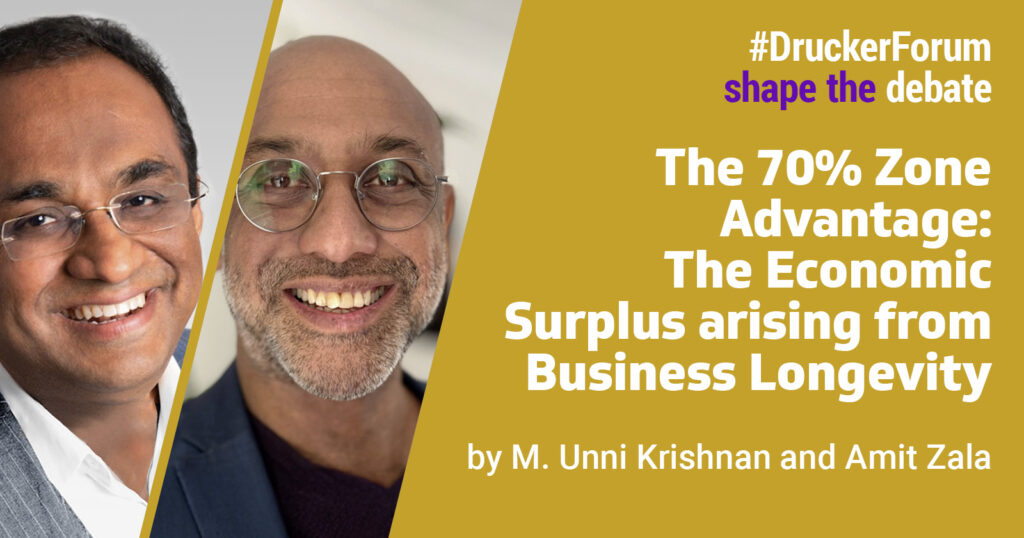
“What everyone knows is usually wrong.” – Peter Drucker
Corporate lifespans are collapsing worldwide – from decades to mere years – yet longevity builds wealth, and wealth builds nations. While most organisations struggle to survive their first decade, a remarkable group of enterprises has endured for generations, creating an institutional backbone of national prosperity and social wellbeing.
What separates these enduring giants from the corporate casualties?
They have mastered what we call the 70% zone of value creation- their “perpetuity value”(PV)- that is the economic marker of business longevity. Their competitors remain fixated on chasing growth in the short-term 30%.
After two decades of pioneering research, grounded in our Lasting Value Creators 100 (LVC100) longitudinal study of 100 companies across a decade, the LivingMachine Institute brings to the Drucker Forum a critical insight: business longevity is the overlooked source of wealth creation. In Drucker’s spirit of questioning yesterday’s logic, we show how leaders can unlock the critical 70% zone and explore why nations must cultivate business longevity as a national strategy, transforming from short-term extraction to perpetual renewal of wealth.
The Backbone of Nations
Among the world’s 50 largest companies by market capitalisation, a remarkable pattern emerges. While younger companies appear to be more valuable, long-lasting organisations act as nation builders by continuing to create value. Companies like JPMorgan Chase (226 years old) and Eli Lilly (149) continue to play a pivotal role in building the US economy. Likewise, Germany’s economy stands tall on the likes of Continental AG (154) and Mercedes-Benz and Bosch (both 139). Switzerland’s economy is built on the foundations of long-lived companies such as Roche (129) and Nestlé (120).
These companies are not nostalgic throwbacks but some of the most valuable economic engines of our time. While new firms unarguably drive dynamism, these enduring enterprises have mastered the alchemy of institutional renewal across generations. Drucker understood this well, seeing effective organisations as “essential bulwarks against tyranny and social dysfunction”, making their persistence crucial for what he called a functioning society.
The Living Design of Wealth
Beneath the observable mechanics of commerce lies what we call the “triad of the LivingMachine”: truth, vitality, and prosperity, the essential qualities that create perpetual wealth.
Truth manifests as unified observer ship – the ability to see things as they are by confronting dogmas and contradictions. This aligns with Drucker’s insight that ‘the greatest danger in times of turbulence is not the turbulence – it is to act with yesterday’s logic.‘
Vitality emerges from the health of the living elements – leadership mindset, purpose, trust, and creative energy. These elements, often mislabelled as “intangibles,” are seen as separate parts, whereas in their unity they represent the life-force of the organisation.
Prosperity represents the 70% zone of value creation – the economic marker of longevity whose regenerative capacities flow from truth and vitality working together. Long-lasting companies seem to have understood this intuitively, developing capacity to steward living systems that can navigate crises and compound value creation across decades.
On average, across our longitudinal studies, we observe that these returns consistently represent around 70% of total enterprise value. Thus, for 50 global companies with more than €50 bn annual revenues and €200 bn in market capitalisation these constitute €18.93 trillion of their total market value of €27.04 trillion. Yet this vast reservoir of value remains unmapped by conventional management theory and practice, and ‘guesstimated’ by capital markets. More critically, it is this reservoir of value that is currently being drained by shareholder value maximisation and the incentivisation of top managers linked to short-term performance.
Longevity as the Economic Marker of a New Age
Perpetuity value is more than a financial formula. It is the most vital economic expression of institutional health we possess, capturing the market’s expectation of an organisation’s capacity to compound value going forward. While finance has long treated PV as an abstract construct, our work anchors it in the health of the living elements of a company, the source of all self-renewal.
Companies operating as “LivingMachines”have consistently demonstrated an ability to create perpetuity contributions above the 70% zone, and business longevity spanning decades. Such firmsinhabit a reality where returns compound rather than increase incrementally, and human beings can flourish rather than exist as cogs in a machine.
Navigating the Twilight Zone
We currently inhabit a twilight zone between two paradigms. The old order has hit the wall, marked by shorter corporate lifespans, deep divisions within society and the systematic destruction of the foundations that create enduring prosperity.
Consider Credit Suisse, once the epitome of Swiss banking excellence, which collapsed from what investigators called “cultural decay and wilful blindness.” Boeing sacrificed its engineering soul for financial metrics, and passengers died in the aftermath. GE delivered stellar results over 188 quarters, yet it still faced bankruptcy, while Starbucks mistook scale for strategy and commoditised its brand through reckless expansion. These are stories of “bleeding insolvency”- the slow rot that occurs when institutions lose touch with the living elements that originally gave them the capacity to renew, adapt and thrive.
The cost extends beyond individual corporations. Credit Suisse’s collapse damaged Switzerland’s reputation as a financial centre. Boeing’s failure weakened America’s national brand and sidelined it in the aerospace market. The bleeding insolvency of iconic companies erodes the foundation of national economic strength which was built through the blood, sweat and tears of the founders and the generations thereafter.
With the old order collapsing, it’s time for companies to start migrating their approach to business success to the timeless principles of vitality, truth and prosperity represented in the triad of the LivingMachine: – the perpetuity value that is taken for granted and extracted today.
The path forward requires embracing Drucker’s fundamental insight: “In a period of rapid structural change, the only ones who survive are the Change Leaders.” Business longevity and the 70% zone advantage awaits those leaders bold enough to abandon yesterday’s extraction model and commit to the patient work of institutional renewal – building not just profitable enterprises, but the living foundations which create perpetual economic surplus, the platform for national prosperity.
This work emerges from the LivingMachine Institute’s two decades of research and practice with enduring organisations, including the landmark LVC100 study of value-creation patterns across 100+ companies over 10 years.
About the authors:
M. Unni Krishnan
Founder and LivingMachine Architect at the LivingMachine Institute
Unni is the founder of the LivingMachine Institute (LMI) – the global pioneer of business longevity economics. His work with iconic business houses in India and Europe reveals the economic marker of business longevity, perpetuity value, which is left unattended resulting in high rates of corporate mortality. His work over nineteen years encapsulated in the LivingMachine model and its attendant tools, reveals the health of the living elements have a distinct capacity to replenish perpetuity value. Companies need to earn their perpetuity value through cultivating the living elements. He is pioneering business longevity as a meaningful alternative to the conventional models and one which can be understood, practiced and institutionalised by owners and leaders worldwide.
Amit Zala
LivingMachine Architect at the LivingMachine Institute
Amit bridges entrepreneurial experience with systemic coaching to help leaders master the practice of business longevity. He enables them to recognise the systemic forces impacting the Living elements of their organisation and visualise its impact on perpetuity value. He is developing the European arm of the institute and co-designs immersive experiences – from diagnostic labs to workshops and LivingMachine journeys – that illuminate the living elements that drive enduring enterprise value. He also leads the LMI’s content creation and research initiatives including the Lasting Value Creators (LVC) global studies.


Vitality as defined by Oxford dictionary is “the state of being strong and active; energy.”
Vitality as applicable to an enterprise (business, for profit, not for profit, or social service) is about the ability of the enterprise to sustain its strength and the state of being active over a long period of time.
While the financial performance of the enterprise (ability to live within means and create a surplus to invest in future) is fundamental, it’s not the end all. Financial performance comes from the collective efforts of people who invest their time, intellect, and physical energy. However, beyond financial performance is the idea of value creation. This value is the creation of a constant source of creative energy. This source is created only when people invest their passion and life energy along with time, intellect and physical energy.
Financially sound enterprise that makes beautiful temples may have stone cutters who are efficient.
A lasting value creating enterprise that makes places of worship to let people nourish their souls will have dedicated “soul nourishers” who by the way are expert stone cutters! They chisel away stones imagining the beautiful structures that stone would morph into, only to nourish their souls.
Such an enterprise creates a lasting value that stands the test of time.
Very well articulated position paper by LongWealth. Thank you @Unni.
Interesting insights on how a company’s long-term performance can contribute to the national economy. I would be keen to see some causal analysis relating firm performance to national economic prowess.